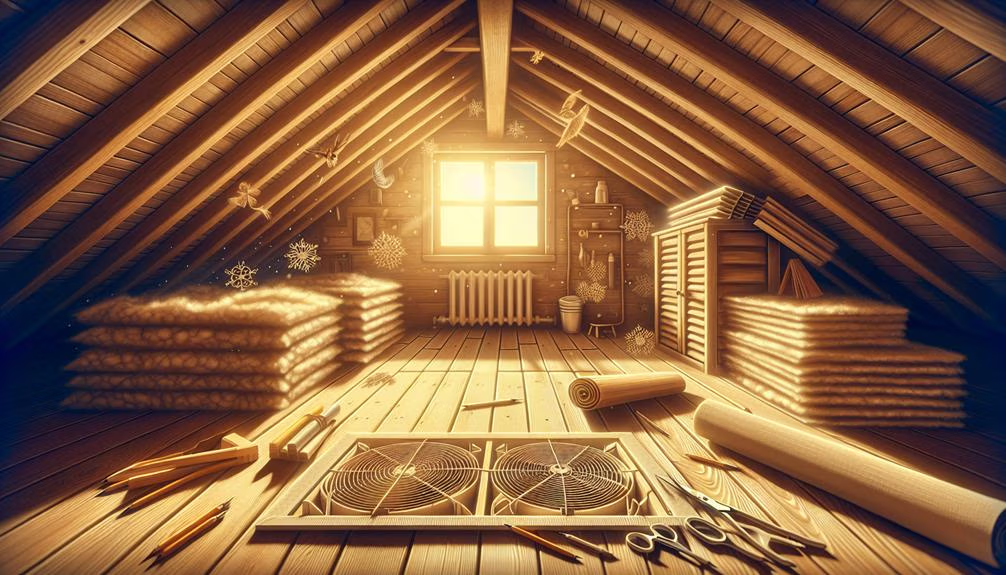Preventing roof leaks is crucial for home maintenance. Conduct regular roof inspections to spot issues early such as missing shingles or damaged flashing. Clean gutters frequently to ensure proper drainage and use gutter guards for added protection. Regularly check and repair flashing, sealing any gaps or cracks. Address shingle damage by replacing cracked or broken ones promptly. Ensure proper attic ventilation to regulate temperature and moisture levels. Trim overhanging branches to prevent physical damage and leaf accumulation. By following these steps, you can significantly reduce the risk of leaks and lengthy repairs – there's much more to keep your roof leak-free!
Maintaining a Healthy Roofing System
- Conduct regular roof inspections to identify and address potential issues early.
- Clean and inspect gutters frequently to ensure proper drainage and prevent blockages.
- Maintain and repair flashing to seal gaps and prevent water infiltration.
- Repair or replace damaged shingles promptly to prevent leaks and further damage.
- Ensure proper attic ventilation to regulate temperature and moisture levels, preventing condensation and leaks.
Regular Roof Inspections

Conducting regular roof inspections is essential for identifying potential issues early and preventing costly repairs. A well-timed inspection can uncover small problems such as missing shingles, minor leaks, or damaged flashing before they escalate into significant, more expensive issues. Ideally, these inspections should be conducted biannually, in the spring and fall, to assess any damage caused by seasonal weather changes.
To perform an effective roof inspection, one should start by examining the overall condition of the shingles. Look for signs of warping, cracking, or missing pieces. Attention should also be given to the flashing around chimneys, vents, and skylights, as these areas are particularly susceptible to water infiltration. Additionally, any signs of moss or algae growth should be addressed promptly, as these can degrade the roofing material over time.
Engaging a professional roofing contractor for a thorough inspection can provide a more comprehensive assessment. Professionals have the expertise to identify subtle signs of damage that may not be visible to the untrained eye. Regular roof inspections not only prolong the lifespan of the roof but also contribute to the overall safety and integrity of the home.
Clean Gutters Frequently
Regularly cleaning gutters is crucial for preventing roof leaks, as accumulated debris can obstruct proper drainage. Ensuring that gutters are free from leaves, twigs, and other blockages allows rainwater to flow smoothly away from the roof. This simple maintenance task can significantly reduce the risk of water damage and extend the life of your roofing system.
Remove Debris Regularly
Keeping gutters free of debris is essential to prevent water from pooling on the roof and causing leaks. When gutters are clogged with leaves, twigs, and other debris, they can no longer efficiently channel water away from the roof, leading to potential damage and leaks. Regular maintenance of gutters and downspouts ensures that water flows freely and does not accumulate in areas where it can seep into the roof structure.
Here are four key steps to keep your gutters clean and functional:
- Inspect Regularly: Conduct routine inspections of your gutters, especially after heavy storms or during the fall when leaves are abundant. Early detection of clogs can prevent more significant issues.
- Clear Debris: Remove any build-up of leaves, twigs, and dirt. Use a garden trowel to scoop out debris, and flush the gutters with a garden hose to ensure all obstructions are cleared.
- Install Gutter Guards: Consider installing gutter guards to reduce the frequency of cleaning. These guards prevent large debris from entering the gutter while still allowing water to flow through.
- Check Downspouts: Ensure downspouts are clear and direct water away from the foundation of your home. A clogged downspout can cause water to back up and overflow, leading to roof leaks.
Ensure Proper Drainage
Maintaining proper drainage is crucial to prevent roof leaks, making it essential to clean your gutters frequently. Clogged gutters can cause water to back up, leading to water damage in your roof's structure and interior spaces. Regularly inspecting and cleaning your gutters ensures that rainwater flows smoothly away from your home, thereby reducing the risk of leaks.
Gutter cleaning involves removing leaves, twigs, and other debris that can accumulate and obstruct water flow. This task, although seemingly mundane, plays a critical role in maintaining the overall health of your roofing system. In addition to cleaning, it's advisable to check for any signs of rust, damage, or sagging, as these can also impede proper drainage.
Below is a table outlining the key actions and their corresponding benefits:
| Action | Benefit |
|---|---|
| Remove debris regularly | Prevents water overflow |
| Inspect for rust/damage | Extends gutter lifespan |
| Check for sagging gutters | Ensures effective water flow |
| Install gutter guards | Reduces debris accumulation |
These steps, when performed consistently, not only safeguard your roof but also enhance the longevity of your gutter system. By maintaining proper drainage, you can significantly mitigate the risks associated with roof leaks, ensuring a safe and dry home.
Fix Flashing Issues

To address potential roof leaks effectively, it is crucial to ensure that all flashing components are correctly installed and in good condition. Flashing, typically made from metal, is used to seal and protect joints in a roof, such as around chimneys, vents, and skylights. Proper flashing installation is key to maintaining the integrity of these vulnerable areas and preventing water infiltration.
To fix flashing issues, consider the following steps:
- Inspect Regularly: Conduct routine inspections, especially after severe weather. Look for signs of rust, corrosion, or any visible damage. Prompt identification of issues can prevent minor problems from escalating.
- Seal Gaps and Cracks: Use a high-quality sealant to address any gaps or cracks in the flashing. This simple step can significantly reduce the risk of leaks by ensuring water does not penetrate the flashing.
- Replace Damaged Flashing: If the flashing is severely damaged or corroded, replacement may be necessary. Ensure the new flashing is installed correctly, conforming to the roof's contours and secured firmly in place.
- Maintain Adjacent Materials: Ensure that the roofing materials surrounding the flashing are also in good condition. Problems with adjacent materials can compromise the effectiveness of the flashing, leading to leaks.
Repair Damaged Shingles
To effectively prevent roof leaks, it is crucial to address any damaged shingles immediately. Begin by identifying shingle damage, followed by replacing any broken ones and securing loose shingles. Proper maintenance in these areas will significantly enhance the longevity and integrity of your roof.
Identify Shingle Damage
Spotting early signs of shingle damage is crucial for preventing roof leaks and ensuring the longevity of your roofing system. Regular inspections can help identify minor issues before they escalate into significant problems. Here are key indicators to look out for:
- Curling or Buckling Shingles: Shingles that are curling or buckling are typically past their life expectancy and could allow water to seep underneath, leading to leaks. Inspect your roof from ground level or use binoculars to spot these signs.
- Missing Shingles: High winds, heavy rain, or storm damage can cause shingles to become loose or fall off. Missing shingles expose the underlayment to the elements, increasing the risk of leaks.
- Granule Loss: Check your gutters and downspouts for an accumulation of granules. Shingles shed granules as they age, which compromises their effectiveness. Bald spots on shingles are a clear sign that they are nearing the end of their lifespan.
- Cracked or Broken Shingles: Physical damage such as cracks or breaks can occur due to impacts or weather conditions. These damaged shingles can no longer provide adequate protection against water infiltration.
Replace Broken Shingles
Addressing broken shingles promptly is essential to maintaining the integrity of your roof and preventing potential leaks. Damaged shingles compromise your roof's ability to repel water, increasing the likelihood of leaks that can lead to costly repairs. Regular inspection and timely replacement of broken shingles can mitigate these risks effectively.
When identifying broken shingles, look for visible cracks, missing granules, or curling edges. Once identified, replacing them involves careful removal of the damaged shingles and installation of new ones. This process not only restores the roof's protective barrier but also extends its overall lifespan.
Consider the following points when replacing broken shingles:
| Key Steps | Details |
|---|---|
| Safety Precautions | Use a sturdy ladder and wear gloves |
| Tools Required | Pry bar, hammer, replacement shingles |
| Removal Process | Gently lift and remove broken shingles |
| Installation Process | Securely nail the new shingles in place |
Properly replacing broken shingles ensures that your roof remains watertight and durable. While some homeowners may attempt this repair themselves, hiring a professional roofer guarantees that the job is done correctly and safely. By addressing shingle damage promptly, you can protect your home from water damage and maintain the aesthetic appeal of your roof.
Secure Loose Shingles
Ensuring loose shingles are securely fastened is crucial for preventing roof leaks and maintaining the structural integrity of your home. Loose shingles can create gaps that allow water to seep through, leading to potential damage not only to your roof but also to the underlying structures of your house. Taking proactive measures to secure any loose shingles will help you avoid costly repairs and extend the lifespan of your roof.
Here are four essential steps to properly secure loose shingles:
- Inspect the Roof Regularly: Conduct thorough inspections, especially after severe weather, to identify any loose or damaged shingles. Look for signs such as lifted edges or missing nails.
- Reattach Loose Shingles: Use roofing nails and a hammer to reattach any loose shingles. Ensure the nails are driven through the shingle into the roof deck for a secure fit.
- Seal with Roofing Cement: Apply roofing cement under the loose shingle and press it firmly into place. This adds an extra layer of protection against water infiltration.
- Replace Damaged Shingles: If a shingle is too damaged to be reattached, it is best to replace it entirely. Cut away the damaged shingle and install a new one in its place, securing it with nails and sealing with roofing cement.
Check Attic Ventilation

Proper attic ventilation is crucial in preventing roof leaks and maintaining the overall health of your roofing system. When an attic is well-ventilated, it helps regulate temperature and moisture levels, which in turn prevents the formation of condensation. Excessive moisture can lead to the deterioration of roofing materials and ultimately result in leaks.
To ensure your attic is properly ventilated, it is essential to have a balanced system of intake and exhaust vents. Intake vents, typically located at the eaves or soffits, allow cool air to enter the attic. Exhaust vents, often situated at or near the roof ridge, enable warm, moist air to escape. This continuous airflow helps maintain an optimal environment in the attic, reducing the risk of moisture buildup.
Regularly inspect your attic for signs of poor ventilation, such as damp insulation, mold growth, or a musty odor. Address any blockages in the vents promptly to maintain effective airflow. Additionally, consider consulting a professional to evaluate the adequacy of your current ventilation system and recommend improvements if necessary.
Trim Overhanging Branches
Overhanging branches pose a significant risk to your roof, as they can cause physical damage and contribute to moisture buildup. Regularly trimming these branches is a crucial step in roof maintenance. Here are four key reasons to keep branches trimmed:
- Prevent Physical Damage: Branches that scrape against shingles can wear down protective layers, leading to cracks and leaks. During storms, larger branches can break and cause severe damage.
- Reduce Moisture Accumulation: Leaves and debris from overhanging branches can accumulate on your roof and in your gutters. This buildup can trap moisture, which promotes the growth of mold and mildew, and eventually leads to leaks.
- Minimize Pest Intrusion: Overhanging branches provide a bridge for pests such as squirrels and raccoons to access your roof. These animals can damage shingles and even chew through roofing materials, creating entry points for water.
- Enhance Sunlight Exposure: Trimming branches allows more sunlight to reach your roof, helping to keep it dry and reducing the risk of moss and algae growth, which can deteriorate roofing materials over time.
Frequently Asked Questions
How Can Weatherproof Coatings Help Prevent Roof Leaks?
Weatherproof coatings play a crucial role in preventing roof leaks by providing a protective barrier against water infiltration. These coatings seal small cracks and imperfections on the roof surface, enhancing its resistance to rain, snow, and other harsh weather conditions. Furthermore, they offer UV protection, which helps to extend the roof's lifespan by preventing material degradation. Applying weatherproof coatings is a proactive measure to maintain roof integrity and prevent costly damages.
What Are the Signs of Poor Roof Drainage?
Just as an overflowing river hints at weak embankments, poor roof drainage reveals itself through telltale signs. Look for persistent water pooling, sagging gutters, and water stains on ceilings or walls. Mold growth and peeling paint are also red flags. Regular inspection is crucial, as these symptoms often precede more severe structural damage. Addressing these issues promptly can safeguard your home from further water-related complications.
Can Installing a Drip Edge Reduce Roof Leaks?
Yes, installing a drip edge can significantly reduce roof leaks. A drip edge prevents water from seeping under the shingles and directs it away from the fascia and underlying roofing components. This helps maintain the integrity of the roof structure and mitigates potential water damage. Proper installation of a drip edge is a crucial step in ensuring effective roof drainage and extending the life of the roofing system.
How Do Ice Dams Contribute to Roof Leaks?
Imagine a winter scenario where melting snow refreezes at the roof's edge, creating a formidable barrier. This is an ice dam. As snow continues to melt, it has nowhere to go but under shingles, leading to leaks. The trapped water can seep into your home, causing significant damage to ceilings, walls, and insulation. Thus, ice dams are a major contributor to roof leaks, demanding prompt attention and preventive measures.
Should I Consider a Roof Replacement for Older Roofs With Frequent Leaks?
Yes, considering a roof replacement for older roofs with frequent leaks is advisable. Persistently leaking roofs often signify underlying structural issues that simple repairs may not resolve. A new roof not only ensures enhanced protection against leaks but also improves energy efficiency and overall home value. Consulting with a professional roofer will provide a thorough assessment of the condition and the best course of action for your specific situation.
Conclusion
In conclusion, the prevention of roof leaks is paramount to safeguarding the structural integrity and longevity of any building. Regular inspections, frequent gutter cleaning, prompt flashing repairs, timely shingle maintenance, proper attic ventilation, and trimming overhanging branches are not just recommendations—they are imperatives. Neglecting these critical measures could result in catastrophic damage, exorbitant repair costs, and severe disruption to everyday life. The diligence in roof maintenance cannot be overstated; it is an absolute necessity for enduring protection.






